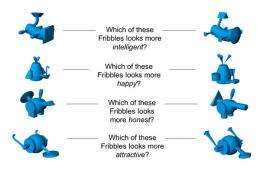Lefty or Righty? A new hold on how we think

(PhysOrg.com) -- Whether you’re a lefty or righty, chances are you never thought your dominant hand played a role in the decisions you make. But what may seem as an unimportant trait might actually influence everything from what cereal you buy to whom you vote for, according to a study by Daniel Casasanto, who conducted the research as a postdoctoral scholar in psychology at Stanford.
The way we interact with the physical world affects our judgments, Casasanto said. Because people with different body types interact with the world different ways, they also make different judgments. For example, a colorblind person will think differently about a shiny red apple than someone with perfect vision. In a similar way, righties and lefties think differently about what’s in front of them.
After testing both righties and lefties in five experiments, Casasanto - now at the Max Planck Institute for Psycholinguistics - found that righties tend to judge objects on their right side as positive and objects on their left side as negative. Lefties do the opposite, pairing positive things with their left side and negative things with their right.
That association could apply in situations ranging from whether we choose one brand of cereal over another simply because of its spot on a grocery store shelf to whom we might identify as a criminal suspect because of their position in a police lineup.
“We have this illusion that we base our decisions largely on relevant and sufficient information, yet social psychology over the past decades has shown us that there are lots of other factors that shape our judgments. And they shape our judgments more than we’re aware of,” Casasanto said.
In one test, 286 students were shown pairs of fictional alien figures called Fribbles, odd animal-like creatures with squiggly appendages. The students were shown two groups of Fribbles, one group on the right side and the other on the left.
Right-handed students were more likely to view the Fribbles on the right side as intelligent, happy, honest and attractive. Lefties judged Fribbles on the left more favorably.
Each of the study’s five experiments showed that students were more likely to associate positive ideas with their dominant side and negative ideas with their less dominant side.
The results challenge the implications of common phrases that people use in a world set up for righties, such as “my right-hand man” or “two left feet” that imply right is good and left is bad. “For left-handed people, implicitly, they think good stuff is on the left and bad stuff is on the right, even though consciously, explicitly, everything in language and culture is telling them the exact opposite,” he said.
People show handedness preference in their actions even without knowing it, Casasanto said. He analyzed all the speech and gestures from the 2004 and 2008 presidential election debates, noting which hand each politician used to gesture when speaking of something positive or negative.
“Righties are more likely compared to lefties to gesture with their right hand when they’re talking about good stuff and lefties to gesture with their left hand when they’re talking about good stuff,” he said. Casasanto and his team are still studying how this might influence the votes of viewers.
Whether or not politicians’ gestures win or lose them votes, Casasanto’s study implies that where a candidate’s name is placed on a ballot could matter. Some states, for example, arrange candidates for the same office opposite each other in a left-right arrangement. So it’s possible that a left-handed voter who doesn’t have much information or a strong opinion on the candidates may be more inclined to pick whoever’s name happens to be on the left side of the ballot, Casasanto said.
“Knowing about this body specific, left-right preference could help us to create ballots that give a more accurate measure of popular sentiment and are free of the biases created by the arrangement of names on the ballots themselves,” Casasanto said.
Another possible benefit of understanding how physical experiences influence our preferences could be an improved education system.
“If righties write the textbook and create the exercises and set up the classrooms, they’re likely to arrange things according to this implicit ‘right is good’ preference,” Casasanto said. “Maybe that’s going to make learning math or going to school and sitting in the classroom just a little bit less pleasant or more disconcerting for lefties. Potentially, sensitivity to this could create better learning environments for lefties.”
Casasanto’s paper is in the August edition of Journal of Experimental Psychology: General.
Provided by Stanford University (news : web)













